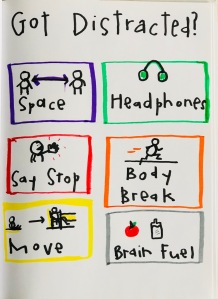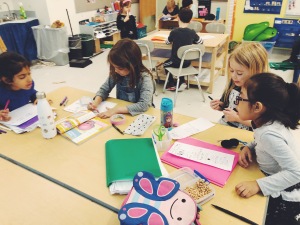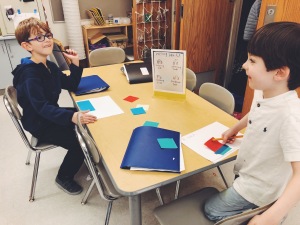Turbulence in the Writing Process
I had ambitious plans for writing while traveling. I buckled into my assigned seat – tucked between two strangers – unpacked my laptop and encountered a wave of challenges.
I froze at the thought of my writing process being visible to “the world.” What followed was the impossible reality that I had to stay in one position, both uncomfortable and unnatural. Without tools for alternating noisy and silent backgrounds, it was difficult to concentrate. Those whom I trusted feedback from, unreachable. This new writing habitat did not provide my needs, and I struggled to thrive.
I wondered if my kindergartners experienced similar roadblocks in their daily writing practice. Assigning seats, limiting noise and movement, and declaring writing a “no snack time” might have made for a more manageable independent writing time for me, but was it hindering engagement and joy in my young writers? Was I preventing kids from discovering writing positions and places that helped them feel creative and productive? Did they notice needs of their bodies and minds to re-energize? Positioned in opposite ends of the classroom from their friends, did they, too, feel isolated from support?
Curious, and motivated to make my writing workshop more kid-driven, I began the school year in a new territory, free from assigned seating.
A Shift in Mindset
For my writers to be successful at navigating an environment to find a just-right spot, and use tools to persist through the writing process, I needed to shift an idea that I’d held onto for years,
from:
Some kids need me to assign them writing spots and tools to be productive and focused,
to:
ALL kids are capable of choosing where and how they write and can select tools as needed, with guidance and support.
I realized the power didn’t lie in the environment and tools to keep kids engaged; the power lied in the kids, who I could teach to utilize choices in the environment and tools as a resource for staying engaged.
What Does Teaching into Choice Look Like?
1. Encourage kids to experiment with different writing spots and tools (headphones, read-to-self phones, visuals, timers, sensory tools like silly putty and fidgets) when launching writing workshop. Invite them to reflect, both individually and in community conversations. “I write best when I have…when I am in a spot that is…”

Focus on the what and the how when it comes to identifying challenges and strategies. What is tricky? My friend and I are talking to each other too much. How can I problem-solve? We can turn our bodies back to back, get space, talk about writing, etc. With patterns, we can learn about ourselves, “I’m the kind of writer who writes best in a private place…away from toys…while talking through and acting out my plans.”

2. Grow and revise the space together. Headphones became a new addition to our classroom when we problem-solved during share: “It helps some of us to talk when we write. But some of us get distracted when it’s noisy. What can we do to make this a space for some writers to talk and some writers to have silence?” Writers might also notice or request bright or dim areas, privacy nooks, places to move, areas to share and offer feedback. Take pictures of kids in various writing positions and paste these on charts for the class to sort and label.

3. Notice it. Name it. Share it. Repeat. Kid-watch through the lens of self-regulation. “Today it got so noisy that it was hard for Ainsley to concentrate. Ainsley didn’t stop writing. She put on a pair of headphones and finished her book. What else could Ainsley have done when it got too noisy? Turn and talk to a neighbor!”

4. Spaces and tools belong to the community, not to individual writers. All kids benefit from and deserve access to all types of seating and resources. Empathy and flexibility are used to problem-solve: “I really need this wiggle stool right now. Can I use it for the first part of writing and you use it for the second?”

5. Let flexible seating be flexible. Many writers prefer shifting their workspace each day or within independent writing time, based on what they need. While planning, Lauri used the trampoline as a comfortable place to sort his writing. Then, he said, “I am feeling tired, can I write in the bright hallway?”

6. Before taking choices away, ask:“Will this new structure make it easier for me to control my kids in their environment, or will it propel my writers towards greater independence?” Think of challenging times as opportunities to grow, through conferences, strategy groups, or community conversations during share, focused on the questions: What felt tricky about writing today? What can we do tomorrow to help us stay more focused?

Lessons from My Kindergarten Writers
Kids can find places to write with ease. In fact, they invent new writing spots. A plant pot turned upside down becomes a kneeling tool. A triangular hollow block is used to lean on. The possibilities of cardboard boxes are limitless. Some writing spots (i.e. hallway) are so popular, they need a sign-up. Kids write in places they love and near people they love – beneath the plants, in the pretend center, within their new block structure, nestled among books they could use as inspiration in the library.
Some writers like to return to the same spot each day, but many writers prefer to write in new places throughout the week. With undefined and ever-changing writing spaces, the classroom can transform into a community of writers. Kids are surrounded by new writers, and therefore, new voices each day. Partnerships and collaboration form on their own, in beautiful ways that cannot be planned for.
Engagement is highest when kids have ownership of where they write. This ownership grows into agency – paper choice, writing tools, use of color, genre, and purpose. To stay engaged, kids learn to self-regulate. Self-regulation is a cog in the wheel of the writing process, moving writers towards greater independence and longer stamina (so long, we had to make writing workshop one hour).
Kids are capable of much more than choosing a spot. Once we believe it, it becomes the true north in every plan and decision we make.
Read More About it: Kid-centered teaching, flexible learning environments, and self-regulation
- Kids First from Day One, by Kristine Mraz and Christine Hertz
- The Space, a Guide for Educators, Dr. Robert Dillon and Rebecca Louise Hare
- Self-Regulation Visuals, Stuart Shanker
- Classroom Environment Reflection and Checklists, Stuart Shanker
- The 7 Principles, Universal Design of the Classroom Environment
- Flexible Seating Options, by Stacey Shubitz
- Before You Silence, Listen, by Kelsey Corter
Kelsey Corter, a Wisconsin native, moved to New York City to be closer to TCRWP and the progressive teaching being done in public schools. She is the lead learner in a kindergarten classroom where play, inquiry, and kids drive the curriculum. You can follow Kelsey’s reflections and discoveries at http://smallsteps.blog, on Twitter @kelsey_corter and on Instagram @theorganicclassroom.


It wasn’t till my final year in the classroom that I allowed kids to have food during writing time. What a difference t made when their bellies were full! After all, as a writer, I snack (maybe a little too much).
I think it is important for all of us to take a step back to determine why we are asserting control. From there, we can take steps to back off so that we are serving students well.
LikeLike
Love the anchor charts!
LikeLike
Kelsey, I love the idea of creating a more flexible learning environment! The comparison of sitting in the center seat on a plane really brings home the point of how space can impact the writing process. As writers, we know having a comfortable, inviting space can really make a difference. Great post!
LikeLike
I MISS you Kelsey Corter!!! You are so full of creativity and wisdom. What an inspiration you are to me as well as your students!
LikeLike
Awww, Hi Jen!! I miss you!!!! This made my day to see, thank you so much. You were an early inspiration for me and still are! Let’s catch up soon.
LikeLike
Thank you so much for your thoughtful and kind comment, Lanny! I’ve become such a more empathetic writing teacher after becoming a writer, myself. Something that seems so little, like where we write, can make such a big difference. It does for me!
LikeLike